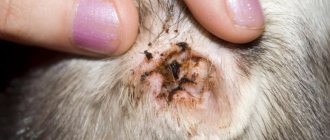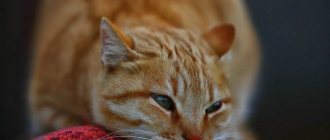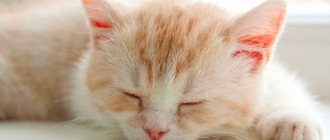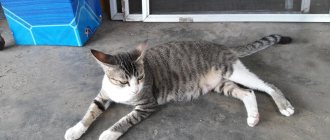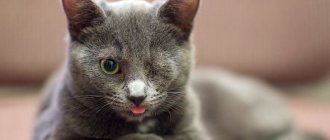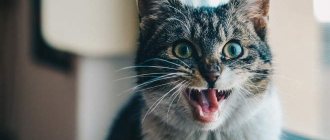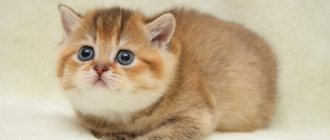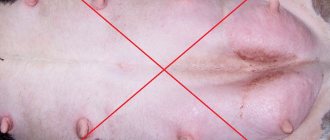Constipation in a domestic cat is a fairly common phenomenon, and every caring owner should know how to identify it and how to deal with it. Retention of feces in the intestines not only causes discomfort to the pet, it is also dangerous, as it threatens intoxication and disruption of the functioning of other organs and systems. In severe cases, constipation can even lead to death, so you need to know how to treat your pet and always have a cat laxative in your medicine cabinet; these include Duphalac, Lactusan, Metamucil, Bisacodyl and some others.
In this article, we write not only about the best laxatives for cats, but also about the causes and symptoms of constipation, as well as when an animal can actually be given medication. We advise you not to skip these sections, because before choosing a medicine, you need to understand what caused the disease. In addition, in some cases, laxatives are contraindicated for a cat, for example, if constipation is caused by stress. But if you only want to know about the best laxatives to give to cats, then refer to the table of contents.
About the causes of constipation
Prolonged absence of bowel movements is an alarming symptom; the condition can be accompanied by severe pain. Feces accumulated in the gastrointestinal tract can, over time, cause inflammatory processes, intoxication of the body, and in severe cases lead to complete intestinal obstruction. In the latter case, death is possible.
Delayed defecation has a clear gradation in medicine; it is divided into:
- According to the organic mechanism of action.
Feces are retained in the intestines due to physical obstacles in the form of tumors, neoplasms, and scars.
- According to the functional mechanism of action.
The cat stops going to the toilet due to insufficient activity of the gastrointestinal tract. Reasons: sedentary lifestyle, inappropriate food, inflammation, intoxication, metabolic disorders, chronic diseases.
Also, a distinction is made between partial stool retention (feces are excreted in a minimal amount, the bulk is retained in the body), and complete stool retention (feces remain completely in the intestines).
Additional symptoms to watch out for:
- Painful bowel movements - the animal screams during bowel movements and experiences pain when palpating the abdomen. Possible causes: gastroenteritis, diseases of internal organs, mechanical damage to the pelvis.
- intense bowel movements - a small predator often visits the toilet, feces come out in small portions or there is no bowel movement at all. Constipation gives way to diarrhea, stool has a liquid consistency. Possible causes: gastroenterocolitis, enterocolitis.
Problems with bowel movements often occur as an additional symptom to chronic diseases.
- Inflammatory processes in the gastrointestinal tract develop due to irregular nutrition, too cold or hot food, monotonous diet, poisoning, allergic reactions, parasites, infections. The disease is accompanied by constipation, vomiting, loss of appetite, and aggressive behavior of the animal.
- Inflammation of the pancreas (pancreatitis) develops both as an independent disease and in the case of parasitic infection. Signs: lack of bowel movements, loss of appetite, pain, bloating in the abdominal area.
- Increased gas formation is observed in animals due to improper feeding. Flatulence is accompanied by constipation, the stomach swells and becomes hard, the pet experiences pain and screams.
- Gastrointestinal blockage develops due to hairballs trapped in the stomach; bones for food; sedentary lifestyle; foreign objects swallowed by the cat. Signs: feces are not excreted, colic occurs, the pet’s behavior changes, pain and vomiting occur after eating, the stomach is bloated.
- Excess weight (obesity) occurs due to an unbalanced diet, problems with the liver, and endocrine system. The process of defecation occurs rarely, the pet leads a sedentary lifestyle.
- Lack of weight (dystrophy) develops due to a lack of nutrients in feed. The small predator has virtually no defecation, the animal is extremely thin, the fur is dull, and the mucous membranes are bluish in color.
- Helminth infestation. When infected with helminths, a pet loses weight, refuses food or eats excessively, constipation gives way to diarrhea, behavior changes, the stomach increases in size, and itchy sensations appear in the anus.
Be sure to read:
Urinary incontinence in cats: causes and treatment, symptoms, medications and alternative treatments
Treatment of constipation with various drugs is directly related to the causes of the unpleasant condition.
When is a laxative necessary?
Having identified symptoms of constipation in a cat, you should not immediately give it laxatives, be it traditional or medicinal. Sometimes this is absolutely not worth doing.
Sometimes the absence of bowel movements is explained by psychological problems or stress. In such cases, laxatives are not needed. The animal must be calmed and a comfortable environment created.
In difficult cases, your pet should be examined by a veterinarian and undergo a course of treatment with antidepressants.
The cat may not accept the tray, the place where it is, or may not tolerate the filler for some reason. In such cases, the reason for the lack of defecation is also in a stressful state, and the animal needs help: change the type of litter, rearrange the tray, sometimes even buy another toilet.
If the cause of constipation is nutritional problems (prolonged fasting, switching to another food, inappropriate food), then the pet needs a diet.
You should consult your veterinarian on what to feed your cat. In such cases, folk remedies can be used for relief.
Medicines should not be given without a doctor’s prescription, especially if they are intended for humans. In some cases, you can use medications, for example, if the animal has undergone castration or sterilization surgery, the veterinarian will tell you about the appropriate ones.
If the cat does not go to the toilet for more than three days and experiences noticeable discomfort, it can also be helped with medication.
In other cases, if blood or mucous inclusions are found in the pet’s stool, then no medications should be given. There is also no need to give a laxative if constipation is caused by intestinal obstruction due to a foreign body.
In such cases, you can do an enema; this method will help to quickly cleanse the rectum and slightly alleviate the cat’s condition. However, you need to show the animal to a doctor as soon as possible.
Also read the article about what to do if a cat cannot go to the toilet in a big way.
How often should a cat go to the toilet?
Defecation rate for cats:
- Adult pet - 1 time per day.
- Kitten - 1-2 times a day, kittens have an increased metabolism, food is digested faster.
- Elderly animal - 1 time in two days; in pets older than 6 years, the metabolism decreases.
According to veterinarians, constipation is considered to be a delay of three or more days. Associated symptoms: anxiety, lack of appetite.
Doctors recommend examining your pet's stool to identify the disease at an early stage. In a healthy cat, feces are oblong in shape, dark brown in color, and soft in consistency.
Deviations:
- overly dry, cracked “balls”,
- liquid consistency,
- unusual color (gray, yellow, red),
- presence of foreign inclusions
Symptoms
The absence of feces in the tray is a reason to be wary.
A healthy cat defecates once a day, sometimes less or more often. At the same time, the feces are soft, homogeneous and without lumps. If a cat does not go to the litter box for more than 2 days, then the owner should pay attention to changes in behavior. As a rule, the pet climbs into the toilet and characteristically sits down, but nothing happens (or hard fecal balls with a diameter of 0.5–1 cm are expelled). This is a clear sign of a serious bowel problem.
With difficulty defecating, the cat looks lethargic and painful, does not play, sleeps a lot and rarely eats, the abdomen swells and becomes hard to the touch. In severe cases, the animal develops a fever or begins vomiting.
Often the animal stops licking itself, so it looks untidy. When the owner tries to feel the stomach, it reacts painfully.
An attentive owner will diagnose constipation based on suspicious behavior and visible symptoms.
The veterinarian is not limited to visual examination and palpation of the peritoneum. Additionally, an ultrasound, x-ray is prescribed, and blood and urine tests are taken to rule out other diseases.
First aid for constipation
You can quickly help your cat at home by giving the animal an enema or inserting a rectal suppository into the anus.
Rectal laxatives with glycerin for humans can also be used for cats. Half a candle is placed on the cat. Cut the candle lengthwise, carefully insert it into the anus, hold the pet in your arms, stroking the belly in a circular motion to stimulate peristalsis. Repeat the procedure after 4-5 hours; if there is no bowel movement, administer an enema.
Negative symptoms
With this pathology, the pet may visit its litter box frequently and to no avail.
Cats suffering from constipation typically exhibit the following symptoms:
- lethargy;
- pain when pressing on the stomach;
- loss of appetite;
- vomit;
- nausea;
- belching;
- frequent sitting in the tray;
- bloating and hardening of the tummy;
- attempts to avoid contact with people;
- temperature increase.
Treatment at home
In the initial stage, you can get rid of the problem at home.
- Changing your diet.
You need to start feeding the cat fractionally liquid food (5-6 times a day), the portions should be small, you should add a little vegetable oil and bran to the food.
- Feeding with vegetables.
You need to add raw carrots and beets, chopped in a blender, to your daily food. If the cat does not want to eat vegetables, you should squeeze out the vegetable juice through gauze and inject it into the mouth through a syringe without a needle.
- Introduction to the diet of foods that normalize digestion.
Be sure to read:
Vomiting in a cat: causes, what different types of vomit indicate, first aid, treatment, when it is not dangerous
Fermented milk products with low fat content (kefir, fermented baked milk, yogurt) can normalize the animal’s digestive processes.
- Daily massage.
You can massage your cat's belly daily, stroking it clockwise with force.
When do you need veterinary help?
You cannot do it on your own if any alarming symptoms appear that affect your pet’s usual state. A plaintive meow is a signal for help. Listen to your mustachioed pet and try to put off all other things until you find out the cause of the problem.
After abdominal surgery, carefully monitor the timing. Delayed bowel movements in the first days are explained by refusal to feed and weak peristalsis inhibited by anesthesia. If the condition does not return to normal within 2 days, contact your doctor. The cause of the delay may be damage to the walls of the rectum. In this case, repeat surgery will be required.
Laxatives: Top 5
- Medicines based on lactulose (Dufolak, Romfalak, Gudalak). The drugs can be used for a long time, the drugs are suitable for animals, have a gentle effect on intestinal motility, and are safe for health. Bowel movement occurs within 2-3 hours, taken in the morning and evening, single dose - 0.5 mg per kilogram of weight.
- Magnesium sulfate solution. The product acts on receptors in the walls of the gastrointestinal tract, effectiveness is achieved after 7-10 hours. single dose - 2-4 mg.
- "Ramnil" is a medicine made from buckthorn bark. The drug in tablet form is given to the animal once a day. A single dose is half a tablet.
- Carlsbad salt solution. The product helps improve digestion processes and leads to gentle bowel movements. Dilute a tablespoon of powder in 100 ml of water and give to the cat 2 times a day.
- "Izafenin". Taking the powder helps cope with chronic constipation and is used as prescribed by a veterinarian.
Preventing constipation in cats
To prevent constipation in your pet, you should follow these recommendations:
- cats, especially those with long, thick hair, should be brushed regularly (during the period of fur renewal, it is better to do the procedure daily);
- long-haired and very clean cats who carefully care for their coats must be given special pastes that dissolve and remove hair from the gastrointestinal tract;
- The cat should always have free access to clean water (the water should be changed frequently, since the animal will not drink stagnant liquid);
- the cat needs to be provided with a varied and proper diet, and not fed with inappropriate food;
- cats prone to laziness must be regularly involved in games and interesting activities to prevent physical inactivity;
- In order to prevent the cat from swallowing small objects, you should carry out regular cleaning and do not leave children's toys with small parts, handicrafts and other things that may interest the animal in the cat's access area.
Once a year, the cat must be taken to the veterinarian for a medical examination. This will help to promptly identify emerging diseases and, if necessary, begin treatment.
Enema
The procedure is carried out as follows:
- Prepare an enema solution. Dissolve a pinch of salt in warm water. Take an enema.
- Lubricate the animal's anus and the enema tip with Vaseline oil.
- Slowly insert the tip into the anus (in a circular motion).
- Pour in the solution.
- Remove the enema, press the pet's tail to the anus, hold it in your arms for 10-15 minutes.
Be sure to read:
What to do if a kitten cannot poop, how to understand that a cat is constipated?
Vaseline oil for constipation
Vaseline oil is a safe remedy that is given to a cat when there are problems with the intestines. The product can be injected through a syringe into the anus; another option is to inject it into the mouth through a syringe without a needle.
The oil can soften feces. move feces through the intestines. The pet's intestines are emptied 3-5 hours after the administration of the oil. single dose - 3-5 ml.
